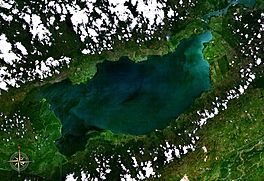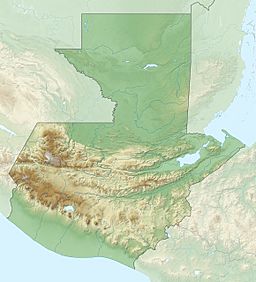Lake Izabal facts for kids
Quick facts for kids Lake Izabal |
|
|---|---|

from space
|
|
| Coordinates | 15°30′00″N 89°10′00″W / 15.5°N 89.1667°W |
| Primary inflows | Polochic River |
| Primary outflows | Río Dulce |
| Basin countries | Guatemala |
| Surface area | 589.6 km2 (227.6 sq mi) |
| Max. depth | 18 m (59 ft) |
| Surface elevation | 1 m (3 ft) |
Lake Izabal is the largest lake in Guatemala. It is sometimes called the Golfo Dulce. This big lake covers about 589.6 square kilometers (227.6 square miles). At its deepest point, it is about 18 meters (59 feet) deep.
The Polochic River is the biggest river that flows into Lake Izabal. The lake is only about one meter (three feet) above sea level. Its water flows out through the Río Dulce. This river then leads to the Gulf of Honduras in the Caribbean Sea.
A very old fort called the Castillo de San Felipe de Lara once protected this lake. It helped guard against pirate attacks. You can still find some old sunken ships nearby. The lake is also home to many amazing animals. These include the gentle Manatee, the powerful Jaguar, and playful Spider Monkeys. You can also spot Howler Monkeys and colorful Blue-eye cichlids. It's a great spot for watching birds too!
Contents
Lake Izabal: Guatemala's Largest Lake
Lake Izabal is a very important natural area in Guatemala. Its large size makes it a key part of the country's geography. The lake's connection to the Caribbean Sea through the Río Dulce is also very special. This link allows boats to travel between the lake and the ocean.
Animals and Nature
Lake Izabal is a rich habitat for many different animals. It is especially known for its population of Manatees. These large, peaceful sea mammals live in the lake's waters. The surrounding forests are home to big cats like the Jaguar. You can also see different types of monkeys, such as Spider Monkeys and Howler Monkeys.
The lake's waters are full of fish, including the unique Blue-eye cichlid. Many different kinds of birds also live around the lake. This makes it a popular place for people who enjoy watching birds in their natural home. Protecting this area helps these animals survive.
History and Culture
The area around Lake Izabal has a long and interesting history. Many indigenous communities live there, especially the Mayas Q'eqchi' people. They have lived near the lake for a very long time.
The Castillo de San Felipe de Lara
One of the most famous landmarks is the Castle of San Felipe de Lara. This castle was built a long time ago, in 1652. It was named to honor a judge named Antonio Lara Mangravo. The main reason for building the castle was to protect the region. Pirates used to sail into the lake from the Caribbean Sea. The castle helped keep the people and their goods safe from these pirate attacks. Today, the castle is a well-preserved historical site. Visitors can explore it and imagine what life was like when pirates roamed the waters.
See also
 In Spanish: Lago de Izabal para niños
In Spanish: Lago de Izabal para niños


